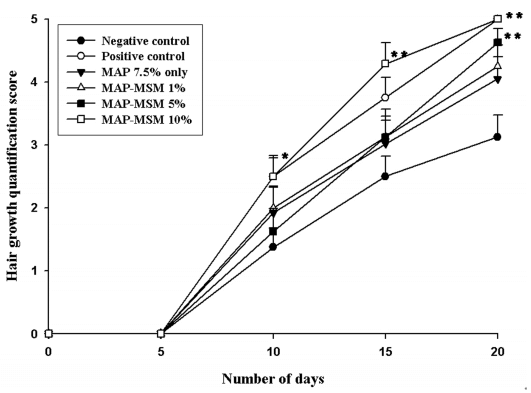There are a variety of products on the market, including Rogaine and Propecia, that aim to target hair loss. What if I told you, however, that a supplement that is found naturally in our bodies and abundantly throughout the world, might help to lessen hair loss and even promote hair growth?
This post will introduce you to MSM, a sulfur-rich compound that has been slowly gaining some buzz over the years. You will learn what MSM is, and how it is believed to work to promote hair growth. This post will also highlight the scientific research showing MSM’s effectiveness in promoting hair growth in mice.
What is MSM?

MSM stands for methylsulfonylmethane. This sulfur-rich, organic compound is used in a variety of industries, including health and beauty, pharmaceutical, and food.
Known by a few other names, including DMSO2, methyl sulfone, and dimethyl sulfone, MSM is found abundantly in nature, as sulfur is one of the building blocks of life.
Just as it is found in nature, MSM is naturally occurring within the human body.
Its main benefit is as an anti-inflammatory agent (1). It also has antioxidant properties that make it beneficial for fighting free radicals.
How Does MSM Work?
To understand how MSM works to promote hair growth, it is first necessary to understand the structure of the hair.
The shaft of the hair is made up of a three-layered structure (2). On the inside is the medulla. Surrounding the medulla is the cortex, the most fibrous part of the hair strand which contains mostly keratin and structural lipids. On the outside of the hair is the cuticle, consisting of dead skin cells that form a protective layer around the hair.

Focusing on the cortex and its keratin-based structure, we find a sulfur-rich environment (3). As mentioned above, sulfur is a building block of life. It is one of the most abundant elements in the human body, and there is no doubt that it contributes significantly to health and wellness (4).
The hair growth cycle consists of three stages (5). They are anagen (growing), catagen (intermediate), and telogen (resting or shedding).
For those looking to promote hair growth and reverse hair loss, anagen is the sought-after stage. MSM is thought to either promote the conversion of telogen to anagen or lengthen anagen, mainly due to the deliverance of sulfur to the middle layer of the hair (6). This both strengthens the strand and encourages further growth.
Additionally, MSM also produces significant amounts of both collagen and keratin (7). These are essential in the development of healthy hair strands.
(Read my article about the importance of collagen here.)
What Does the Research Say About MSM for Hair Growth?
If you are considering MSM as a hair growth treatment, you are in luck – MSM has been shown to have positive effects on hair growth.
A 2009 study aimed to learn whether MSM, when combined with Magnesium Ascorbyl Phosphate (MAP), could be used to effectively treat alopecia in mice (8).
MAP is known to convert hair from the telogen phase to the anagen phase. Researchers, however, wanted to know whether the addition of MSM could bolster these hair-growing effects.
First, researchers prepared the mice by shaving their backs and then applying thioglycolic acid 80% cream to complete hair removal. Next, researchers prepared a variety of solutions for use in the study.
Some of the solutions contained MAP only, others contained a combination of MAP and MSM, and still others were controls of either saline (negative) or Minoxidil (positive).

Visual scoring of the mice was done as shown below:

Now, here is a look at the results of the study.
Shown below are visual hair growth scores of six solutions over several days.

As is seen above, the solution of MAP-MSM 10% has the best scores overall, showing increasingly more hair growth as the period increases.
And here is a visual look at the mice.

Is MSM Effective at Treating Hair Loss?
While the study above does not focus solely on MSM, it does provide us with some valuable results. The study shows that, while MAP alone is effective at promoting hair growth, the solutions containing both MAP and MSM are more effective overall.
The more MSM that was present in the dermal solution, the better the results shown.
Unfortunately, researchers were not able to pinpoint the mechanism which makes MSM so effective. However, the results do speak for themselves showing that MSM can be effectively used to treat alopecia in mice.
While no human studies have been done, there is no reason that similar results cannot be seen in humans as they are shown above in the mice.
How to Supplement with MSM
There are two main ways to supplement with MSM.
Eat More MSM-Rich Foods
It is best to get your nutrients from food sources and, fortunately, there is an abundance of them. These sources include fruits, vegetables, grains, beer, port wine, coffee, tea, and cow’s milk (9).
Unfortunately, it is not possible to ingest enough MSM from food sources. That is where supplements come in.
Use a Supplement
There are a variety of MSM supplements available on the market, though the most common forms include powder, capsule, and tablet.
To take MSM, you can add the powder to smoothies or just plain water. As for the capsules and tablets, it is recommended you take them with food if you are sensitive to gastrointestinal side effects that may occur (10).
To lessen the impact of said side effects, begin taking the supplement in doses that are less than recommended.
Gradually work your way up to the recommended dose, pulling back and starting again at a lower dose if side effects are noticed.
Recommended Dosage
As MSM is not currently a drug that is FDA approved for use, there is not yet a universally recommended dosage.
There have been studies that show that MSM is safe to take in larger doses – between 500 milligrams and 3 grams daily (11). But that does not mean you should start with such a high dose.
It is best to speak with your doctor before you decide on a dosage, or before you even begin with supplementation.
Brands, Availability, and Cost
MSM is available both online and in stores, typically found in the joint support section of the pharmacy. This is due to its sulfurous makeup, which contributes to inflammation and pain relief (12, 13).
Price will vary by brand and location, though Amazon has a few options ranging from 120 capsules at $7.59 to 240 capsules at $16.09.
When choosing a brand, be sure to consider the dosage amount.
Risks and Potential Side Effects
While it appears that side effects are minimal, there is limited human research on its use.
In studies performed on rats, mice, and dogs, the most common side effect was mild skin and eye irritation from the topical application (14).
In one study performed on humans, mild gastrointestinal effects and insomnia were reported (15).
With such little information available, vulnerable populations should avoid using MSM internally or topically. These populations include women who are pregnant or breastfeeding, people who are taking a prescription medication, and people with underlying medical conditions.
If you would like to add MSM to your routine, be sure to speak with your doctor about the risks.
Conclusion
Further studies are necessary to better understand MSM’s effect on hair growth. However, the current research does give a glimmer of hope to those suffering from hair loss.
Of course, there is no such thing as the perfect treatment. So while you may want to consider adding an MSM supplement to your routine, you should be sure to take a multi-pronged approach to the problem.
Information contained on this website has not been evaluated by any medical body such as the Food & Drug Administration. All information is for educational purposes only. We do not aim to diagnose, treat, cure or prevent any disease or illness. You must consult a medical professional before acting on any content on this website.
